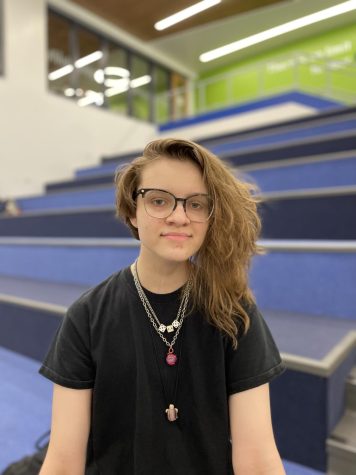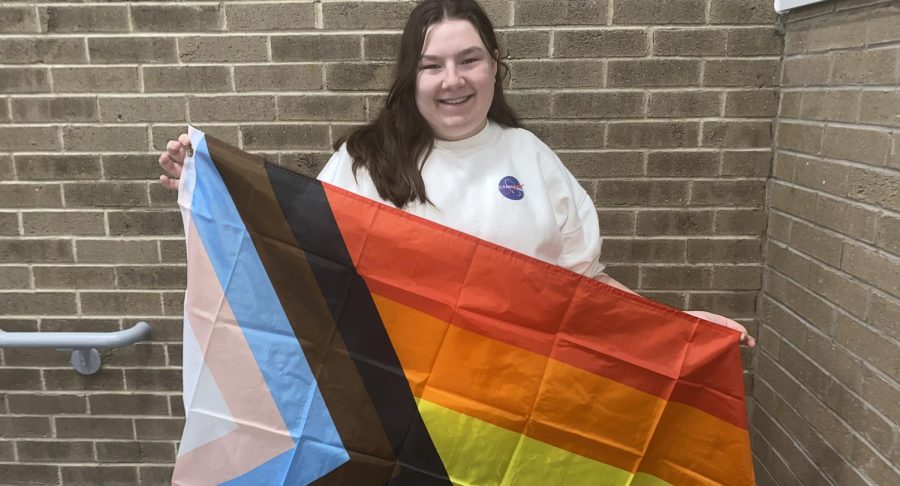Connecting queer experiences
LGBTQ+ students’ representation at school
Photo by Lexy Kushner
Zukowski holds up the LGBTQ+ flag that represents the queer, transgender, and African American communities to show both her pride from being a member of the LGBTQ+ community and support for other members of every community.
For some members of the LGBTQ+ community, experiences like seeing yourself represented at school and feeling included in spaces that can be unsupportive can be tough to come by.
Additionally, for transgender students, using bathrooms, locker rooms, and other spaces defined by your gender can be challenging without gender neutral or gender inclusive options. For the queer community, it can be hard to feel safe and included at school when people might not be accepting of the LGBTQ+ community or claim not to understand.
According to a Bear Facts Student Media survey of 178 people, 38.2% of students are or might be apart of the LGBTQ+ community. Due to this, Emilia Zukowski, sophomore, said she has seen a lot of members of the community around school, both transgender students and queer students.
“I’ve seen a lot of people who are lesbian, trans[gender], or gender fluid, and it’s really nice being able to see those types of people have the same representation as I do,” Zukowski said.
Zukowski, a member of the LGBTQ+ community, said she has seen some representation around the school. Between teachers giving out introduction sheets at the beginning of the year that ask what their students’ preferred names and pronouns are, and the many open members of the LGBTQ+ community that can be seen around school, Zukowski says there is a lot of representation and inclusions for LGBTQ+ students.
“I think [the school is] doing really well [with representation by] having clubs and teachers that are supportive,” Zukowski said. “But they could also bring a little more representation, like talking about the LGBTQ+ community in class more.”
While there is a lot the school is doing to support the LGBTQ+ community and students who identify as apart of the community according to Zukowski, Julia Wangler, sophomore, believes there could be more inclusion for students at school.
“[The school could use] more resources and support for LGBTQ+ students, as some [students] are not supported at home,” Wangler said. “They [should] implement an educational program, similar to the SEL program, that teaches about queer identities and reinforces that they’re normal.”
Wangler says she has seen the school support LGBTQ+ students by adding gender neutral bathrooms and allowing students to use the bathrooms and locker rooms they identify with, but she has struggled with gendered labeled spaces before.
“As someone who is bigender, but usually chooses to present as female because it is easier, I feel that gendered restrooms and locker rooms are a bit limiting. However, I understand that there are some people who feel uncomfortable sharing these spaces with another gender,” Wangler said.
Wangler said she would want more support from teachers, such as using students’ pronouns because some teachers might ask for pronouns and not use them. While it can be hard for teachers to try and remember specific names and pronouns for every student, little signs of support like correctly identifying students can help members of the LGBTQ+ community feel more included in class, a problem Zukowski said she experienced in class before when sharing her pronouns.
“I feel like, besides being open with my friends, I can’t always be truly myself [at school and in class], but if I was more open, maybe I would break my personality out a little bit more and just be my true self in a way,” Zukowski said.
Zukowski says she uses both she and they pronouns, but she usually is not as open as she could be with her identity. Additionally, Zukowski said she knows transgender students at school who she is scared for because of the possibility that they could be mistreated for being transgender.
“I’m scared for my [transgender] friends being treated differently. Some people may be looking at them weirdly because of how they identify. I don’t want that to happen because I care about them and I want them to feel safe,” Zukowski said.
While Zukowski is scared for what negative experiences her transgender friends might have, John, a transgender student whose name has been changed to protect his identity, says he often struggles with teachers and substitutes using his legal name, also commonly referred to as his dead name, instead of his preferred name and the name his classmates and friends know him by.
“It would be great if [the school and teachers] could ask students pronouns and if at all possible on the attendance sheets have a note that says a student goes by different names,” John said. “When substitutes do roll call, and I get dead named, it feels really weird because everyone in my class knows me by a different name, so hearing this weird name gives me anxiety that I’m going to be called that name more and more often.”
According to a Bear Facts Student Media survey of 178 students, 10.1% of students identify or might identify as a part of the transgender community, but only 25% of transgender students feel safe at school. John said they believe one of the ways others could help transgender students feel safe at school is by identifying them correctly.
“There [should be] a reminder to use gender neutral pronouns when meeting someone. It would be really beneficial since teachers and students call me ‘she’ over and over,” John said. “I never said I was a she, they’re using she because they’re not looking at me as a person. They’re hearing my voice, they’re seeing my body, they’re looking at my face, they are not looking at me as a person.”
John said that the main difficulty of being transgender is people who do not know how you identify assuming your gender and misgendering you based on the way you look. He believes one of the biggest struggles for transgender students is finding an opportunity to share their pronouns.
“I feel that there should be a better opportunity for students to say their pronouns without saying it awkwardly to a teacher in conversation,” John said. “I would not be comfortable walking up to a teacher and being like ‘hey please don’t call me she, these are actually my pronouns,’ that’s weird.”
For transgender students, having to come out to teachers and students constantly to be identified correctly can be difficult according to John, especially if students are worried about people being accepting of them and the LGBTQ+ community, which is why Wangler said teachers should always identify transgender students correctly.
“[The school should] always use preferred names and pronouns and protect students’ identities if their parents aren’t supportive,” Wangler said.
For LGBTQ+ students, feeling represented and included at school can be hard, and for transgender students, it can be even harder to feel comfortable in gender specified places such as bathrooms and locker rooms when gender neutral options are not always available or provided. However, safe spaces can always be found in places like clubs such as GSA, supportive teachers, accepting students, and allies all around school.

For their junior year, Lexy is spending their first year on the Bear Facts staff on the opinion/ed section. Outside of journalism, they can be found drawing,...

